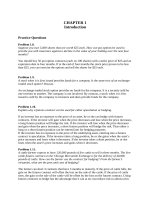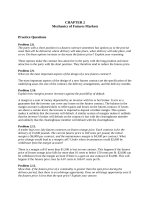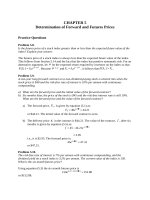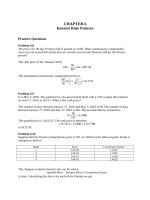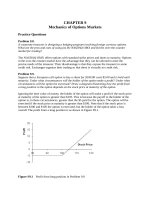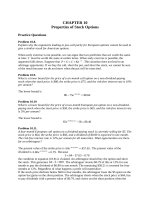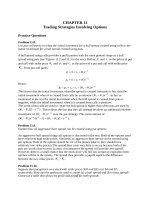Solutions fundamentals of futures and options markets 7e by hull chapter 10
Bạn đang xem bản rút gọn của tài liệu. Xem và tải ngay bản đầy đủ của tài liệu tại đây (74.71 KB, 9 trang )
CHAPTER 10
Properties of Stock Options
Practice Questions
Problem 10.8.
Explain why the arguments leading to put–call parity for European options cannot be used to
give a similar result for American options.
When early exercise is not possible, we can argue that two portfolios that are worth the same
at time T must be worth the same at earlier times. When early exercise is possible, the
argument falls down. Suppose that P + S > C + Ke − rT . This situation does not lead to an
arbitrage opportunity. If we buy the call, short the put, and short the stock, we cannot be sure
of the result because we do not know when the put will be exercised.
Problem 10.9.
What is a lower bound for the price of a six-month call option on a non-dividend-paying
stock when the stock price is $80, the strike price is $75, and the risk-free interest rate is 10%
per annum?
The lower bound is
80 − 75e −0.1×0.5 = $8.66
Problem 10.10
What is a lower bound for the price of a two-month European put option on a non-dividendpaying stock when the stock price is $58, the strike price is $65, and the risk-free interest rate
is 5% per annum?
The lower bound is
65e −0.05×2 /12 − 58 = $6.46
Problem 10.11.
A four-month European call option on a dividend-paying stock is currently selling for $5. The
stock price is $64, the strike price is $60, and a dividend of $0.80 is expected in one month.
The risk-free interest rate is 12% per annum for all maturities. What opportunities are there
for an arbitrageur?
The present value of the strike price is 60e −0.12×4/12 = $57.65 . The present value of the
dividend is 0.80e −0.12×1/12 = 0.79 . Because
5 < 64 − 57.65 − 0.79
the condition in equation (10.8) is violated. An arbitrageur should buy the option and short
the stock. This generates 64 − 5 = $59 . The arbitrageur invests $0.79 of this at 12% for one
month to pay the dividend of $0.80 in one month. The remaining $58.21 is invested for four
months at 12%. Regardless of what happens a profit will materialize.
If the stock price declines below $60 in four months, the arbitrageur loses the $5 spent on the
option but gains on the short position. The arbitrageur shorts when the stock price is $64, has
to pay dividends with a present value of $0.79, and closes out the short position when the
stock price is $60 or less. Because $57.65 is the present value of $60, the short position
generates at least 64 − 57.65 − 0.79 = $5.56 in present value terms. The present value of the
arbitrageur’s gain is therefore at least 5.56 − 5.00 = $0.56 .
If the stock price is above $60 at the expiration of the option, the option is exercised. The
arbitrageur buys the stock for $60 in four months and closes out the short position. The
present value of the $60 paid for the stock is $57.65 and as before the dividend has a present
value of $0.79. The gain from the short position and the exercise of the option is therefore
exactly 64 − 57.65 − 0.79 = $5.56 . The arbitrageur’s gain in present value terms is exactly
5.56 − 5.00 = $0.56 .
Problem 10.12.
A one-month European put option on a non-dividend-paying stock is currently selling for
$2.50 . The stock price is $47, the strike price is $50, and the risk-free interest rate is 6% per
annum. What opportunities are there for an arbitrageur?
In this case the present value of the strike price is 50e −0.06×1/12 = 49.75 . Because
2.5 < 49.75 − 47.00
the condition in equation (10.5) is violated. An arbitrageur should borrow $49.50 at 6% for
one month, buy the stock, and buy the put option. This generates a profit in all circumstances.
If the stock price is above $50 in one month, the option expires worthless, but the stock can
be sold for at least $50. A sum of $50 received in one month has a present value of $49.75
today. The strategy therefore generates profit with a present value of at least $0.25.
If the stock price is below $50 in one month the put option is exercised and the stock owned
is sold for exactly $50 (or $49.75 in present value terms). The trading strategy therefore
generates a profit of exactly $0.25 in present value terms.
Problem 10.13.
Give an intuitive explanation of why the early exercise of an American put becomes more
attractive as the risk-free rate increases and volatility decreases.
The early exercise of an American put is attractive when the interest earned on the strike price
is greater than the insurance element lost. When interest rates increase, the value of the
interest earned on the strike price increases making early exercise more attractive. When
volatility decreases, the insurance element is less valuable. Again this makes early exercise
more attractive.
Problem 10.14.
The price of a European call that expires in six months and has a strike price of $30 is $2.
The underlying stock price is $29, and a dividend of $0.50 is expected in two months and
again in five months. The term structure is flat, with all risk-free interest rates being 10%.
What is the price of a European put option that expires in six months and has a strike price of
$30?
Using the notation in the chapter, put-call parity [equation (10.10)] gives
c + Ke − rT + D = p + S0
or
p = c + Ke − rT + D − S 0
In this case
p = 2 + 30e −0.1×6/12 + (0.5e −0.1×2/12 + 0.5e −0.1×5/12 ) − 29 = 2.51
In other words the put price is $2.51.
Problem 10.15.
Explain carefully the arbitrage opportunities in Problem 10.14 if the European put price is
$3.
If the put price is $3.00, it is too high relative to the call price. An arbitrageur should buy the
call, short the put and short the stock. This generates −2 + 3 + 29 = $30 in cash which is
invested at 10%. Regardless of what happens a profit with a present value of
3.00 − 2.51 = $0.49 is locked in.
If the stock price is above $30 in six months, the call option is exercised, and the put option
expires worthless. The call option enables the stock to be bought for $30, or
30e −0.10×6 /12 = $28.54 in present value terms. The dividends on the short position cost
0.5e −0.1×2 /12 + 0.5e−0.1×5/12 = $0.97 in present value terms so that there is a profit with a present
value of 30 − 28.54 − 0.97 = $0.49 .
If the stock price is below $30 in six months, the put option is exercised and the call option
expires worthless. The short put option leads to the stock being bought for $30, or
30e −0.10×6 /12 = $28.54 in present value terms. The dividends on the short position cost
0.5e −0.1×2 /12 + 0.5e−0.1×5/12 = $0.97 in present value terms so that there is a profit with a present
value of 30 − 28.54 − 0.97 = $0.49 .
Problem 10.16.
The price of an American call on a non-dividend-paying stock is $4. The stock price is $31,
the strike price is $30, and the expiration date is in three months. The risk-free interest rate is
8%. Derive upper and lower bounds for the price of an American put on the same stock with
the same strike price and expiration date.
From equation (10.7)
S0 − K ≤ C − P ≤ S0 − Ke − rT
In this case
or
or
31 − 30 ≤ 4 − P ≤ 31 − 30e −0.08×0.25
1.00 ≤ 4.00 − P ≤ 1.59
2.41 ≤ P ≤ 3.00
Upper and lower bounds for the price of an American put are therefore $2.41 and $3.00.
Problem 10.17.
Explain carefully the arbitrage opportunities in Problem 10.16 if the American put price is
greater than the calculated upper bound.
If the American put price is greater than $3.00 an arbitrageur can sell the American put, short
the stock, and buy the American call. This realizes at least 3 + 31 − 4 = $30 which can be
invested at the risk-free interest rate. At some stage during the 3-month period either the
American put or the American call will be exercised. The arbitrageur then pays $30, receives
the stock and closes out the short position. The cash flows to the arbitrageur are +$30 at time
zero and −$30 at some future time. These cash flows have a positive present value.
Problem 10.18.
Prove the result in equation (10.7). (Hint: For the first part of the relationship consider (a) a
portfolio consisting of a European call plus an amount of cash equal to K and (b) a portfolio
consisting of an American put option plus one share.)
As in the text we use c and p to denote the European call and put option price, and C and
P to denote the American call and put option prices. Because P ≥ p , it follows from put–call
parity that
P ≥ c + Ke − rT − S 0
and since c = C ,
P ≥ C + Ke − rT − S0
or
C − P ≤ S0 − Ke − rT
For a further relationship between C and P , consider
Portfolio I: One European call option plus an amount of cash equal to K .
Portfolio J: One American put option plus one share.
Both options have the same exercise price and expiration date. Assume that the cash in
portfolio I is invested at the risk-free interest rate. If the put option is not exercised early
portfolio J is worth
max ( ST , K )
at time T . Portfolio I is worth
max ( ST − K , 0) + Ke rT = max ( ST , K ) − K + Ke rT
at this time. Portfolio I is therefore worth more than portfolio J. Suppose next that the put
option in portfolio J is exercised early, say, at time τ . This means that portfolio J is worth K
at time τ . However, even if the call option were worthless, portfolio I would be worth Ke rτ
at time τ . It follows that portfolio I is worth at least as much as portfolio J in all
circumstances. Hence
c + K ≥ P + S0
Since c = C ,
C + K ≥ P + S0
or
C − P ≥ S0 − K
Combining this with the other inequality derived above for C − P , we obtain
S0 − K ≤ C − P ≤ S0 − Ke − rT
Problem 10.19.
Prove the result in equation (10.11). (Hint: For the first part of the relationship consider (a)
a portfolio consisting of a European call plus an amount of cash equal to D + K and (b) a
portfolio consisting of an American put option plus one share.)
As in the text we use c and p to denote the European call and put option price, and C and
P to denote the American call and put option prices. The present value of the dividends will
be denoted by D . As shown in the answer to Problem 10.18, when there are no dividends
C − P ≤ S0 − Ke − rT
Dividends reduce C and increase P . Hence this relationship must also be true when there
are dividends.
For a further relationship between C and P , consider
Portfolio I: one European call option plus an amount of cash equal to D + K
Portfolio J: one American put option plus one share
Both options have the same exercise price and expiration date. Assume that the cash in
portfolio I is invested at the risk-free interest rate. If the put option is not exercised early,
portfolio J is worth
max ( ST , K ) + De rT
at time T . Portfolio I is worth
max ( ST − K , 0) + ( D + K )e rT = max ( ST , K ) + De rT + Ke rT − K
at this time. Portfolio I is therefore worth more than portfolio J. Suppose next that the put
option in portfolio J is exercised early, say, at time τ . This means that portfolio J is worth at
most K + De rτ at time τ . However, even if the call option were worthless, portfolio I would
be worth ( D + K )e rτ at time τ . It follows that portfolio I is worth more than portfolio J in all
circumstances. Hence
c + D + K ≥ P + S0
Because C ≥ c
C − P ≥ S0 − D − K
Problem 10.20.
Consider a five-year call option on a non-dividend-paying stock granted to employees. The
option can be exercised at any time after the end of the first year. Unlike a regular exchangetraded call option, the employee stock option cannot be sold. What is the likely impact of this
restriction on early exercise?
An employee stock option may be exercised early because the employee needs cash or
because he or she is uncertain about the company’s future prospects. Regular call options can
be sold in the market in either of these two situations, but employee stock options cannot be
sold. In theory an employee can short the company’s stock as an alternative to exercising. In
practice this is not usually encouraged and may even be illegal for senior managers.
Problem 10.21.
Use the software DerivaGem to verify that Figures 10.1 and 10.2 are correct.
The graphs can be produced from the first worksheet in DerivaGem. Select Equity as the
Underlying Type. Select Analytic European as the Option Type. Input stock price as 50,
volatility as 30%, risk-free rate as 5%, time to exercise as 1 year, and exercise price as 50.
Leave the dividend table blank because we are assuming no dividends. Select the button
corresponding to call. Do not select the implied volatility button. Hit the Enter key and click
on calculate. DerivaGem will show the price of the option as 7.15562248. Move to the Graph
Results on the right hand side of the worksheet. Enter Option Price for the vertical axis and
Asset price for the horizontal axis. Choose the minimum strike price value as 10 (software
will not accept 0) and the maximum strike price value as 100. Hit Enter and click on Draw
Graph. This will produce Figure 10.1a. Figures 10.1c, 10.1e, 10.2a, and 10.2c can be
produced similarly by changing the horizontal axis. By selecting put instead of call and
recalculating the rest of the figures can be produced. You are encouraged to experiment with
this worksheet. Try different parameter values and different types of options.
Further Questions
Problem 10.22.
A European call option and put option on a stock both have a strike price of $20 and an
expiration date in three months. Both sell for $3. The risk-free interest rate is 10% per
annum, the current stock price is $19, and a $1 dividend is expected in one month. Identify
the arbitrage opportunity open to a trader.
If the call is worth $3, put-call parity shows that the put should be worth
3 + 20e −0.10×3/12 + e−0.1×1/12 − 19 = 4.50
This is greater than $3. The put is therefore undervalued relative to the call. The correct
arbitrage strategy is to buy the put, buy the stock, and short the call. This costs $19. If the
stock price in three months is greater than $20, the call is exercised. If it is less than $20, the
put is exercised. In either case the arbitrageur sells the stock for $20 and collects the $1
dividend in one month. The present value of the gain to the arbitrageur is
−3 − 19 + 3 + 20e −0.10×3/12 + e −0.1×1/12 = 1.50
Problem 10.23.
Suppose that c1 , c2 , and c3 are the prices of European call options with strike prices K1 , K 2
, and K 3 , respectively, where K 3 > K 2 > K1 and K 3 − K 2 = K 2 − K1 . All options have the
same maturity. Show that
c2 ≤ 0.5(c1 + c3 )
(Hint: Consider a portfolio that is long one option with strike price K1 , long one option with
strike price K 3 , and short two options with strike price K 2 .)
Consider a portfolio that is long one option with strike price K1 , long one option with strike
price K 3 , and short two options with strike price K 2 . The value of the portfolio can be
worked out in four different situations
ST ≤ K1 : Portfolio Value = 0
K1 < ST ≤ K 2 : Portfolio Value = ST − K1
K 2 < ST ≤ K 3 : Portfolio Value = ST − K1 − 2( ST − K 2 ) = K 2 − K1 − ( ST − K 2 ) ≥ 0
ST > K 3 : Portfolio Value = ST − K1 − 2( ST − K 2 ) + ST − K 3 = K 2 − K1 − ( K 3 − K 2 ) = 0
The value is always either positive or zero at the expiration of the option. In the absence of
arbitrage possibilities it must be positive or zero today. This means that
c1 + c3 − 2c2 ≥ 0
or
c2 ≤ 0.5(c1 + c3 )
Note that students often think they have proved this by writing down
c1 ≤ S0 − K1e− rT
2c2 ≤ 2( S0 − K 2 e − rT )
c3 ≤ S0 − K 3e − rT
and subtracting the middle inequality from the sum of the other two. But they are deceiving
themselves. Inequality relationships cannot be subtracted. For example, 9 > 8 and 5 > 2 , but
it is not true that 9 − 5 > 8 − 2
Problem 10.24.
What is the result corresponding to that in Problem 10.23 for European put options?
The corresponding result is
p2 ≤ 0.5( p1 + p3 )
where p1 , p2 and p3 are the prices of European put option with the same maturities and
strike prices K1 , K 2 and K 3 respectively. This can be proved from the result in Problem
10.23 using put-call parity. Alternatively we can consider a portfolio consisting of a long
position in a put option with strike price K1 , a long position in a put option with strike price
K 3 , and a short position in two put options with strike price K 2 . The value of this portfolio in
different situations is given as follows
ST ≤ K1 : Portfolio Value = K1 − ST − 2( K 2 − ST ) + K 3 − ST = K 3 − K 2 − ( K 2 − K1 ) = 0
K1 < ST ≤ K 2 : Portfolio Value = K 3 − ST − 2( K 2 − ST ) = K 3 − K 2 − ( K 2 − ST ) ≥ 0
K 2 < ST ≤ K 3 : Portfolio Value = K 3 − ST
ST > K 3 : Portfolio Value = 0
Because the portfolio value is always zero or positive at some future time the same must be
true today. Hence
p1 + p3 − 2 p2 ≥ 0
or
p2 ≤ 0.5( p1 + p3 )
Problem 10.25.
Suppose that you are the manager and sole owner of a highly leveraged company. All the
debt will mature in one year. If at that time the value of the company is greater than the face
value of the debt, you will pay off the debt. If the value of the company is less than the face
value of the debt, you will declare bankruptcy and the debt holders will own the company.
a. Express your position as an option on the value of the company.
b. Express the position of the debt holders in terms of options on the value of the
company.
c. What can you do to increase the value of your position?
a. Suppose V is the value of the company and D is the face value of the debt. The
value of the manager’s position in one year is
max(V − D, 0)
This is the payoff from a call option on V with strike price D .
b. The debt holders get
min(V , D )
= D − max( D − V , 0)
Since max( D − V , 0) is the payoff from a put option on V with strike price D , the
debt holders have in effect made a risk-free loan (worth D at maturity with certainty)
and written a put option on the value of the company with strike price D . The
position of the debt holders in one year can also be characterized as
V − max(V − D, 0)
This is a long position in the assets of the company combined with a short position in
a call option on the assets with a strike price of D . The equivalence of the two
characterizations can be presented as an application of put–call parity. (See Business
Snapshot 10.1.)
c. The manager can increase the value of his or her position by increasing the value of
the call option in (a). It follows that the manager should attempt to increase both V
and the volatility of V . To see why increasing the volatility of V is beneficial,
imagine what happens when there are large changes in V . If V increases, the
manager benefits to the full extent of the change. If V decreases, much of the
downside is absorbed by the company’s lenders.
Problem 10.26.
Consider an option on a stock when the stock price is $41, the strike price is $40, the riskfree rate is 6%, the volatility is 35%, and the time to maturity is 1 year. Assume that a
dividend of $0.50 is expected after six months.
a. Use DerivaGem to value the option assuming it is a European call.
b. Use DerivaGem to value the option assuming it is a European put.
c. Verify that put–call parity holds.
d. Explore using DerivaGem what happens to the price of the options as the time to
maturity becomes very large. For this purpose assume there are no dividends. Explain
the results you get.
DerivaGem shows that the price of the call option is 6.9686 and the price of the put option is
4.1244. In this case
c + D + Ke − rT = 6.9686 + 0.5e −0.06×0.5 + 40e−0.06×1 = 45.1244
Also
p + S = 4.1244 + 41 = 45.1244
As the time to maturity becomes very large and there are no dividends, the price of the call
option approaches the stock price of 41. (For example, when T = 100 it is 40.94.) This is
because the call option can be regarded as a position in the stock where the price does not
have to be paid for a very long time. The present value of what has to be paid is close to zero.
As the time to maturity becomes very large the price of the European put option becomes
close to zero. (For example, when T = 100 it is 0.04.) This is because the present value of
what might be received from the put option becomes close to zero.
Problem 10.27
Consider a put option on a non-dividend-paying stock when the stock price is $40, the strike
price is $42, the risk-free rate of interest is 2%, the volatility is 25% per annum , and the time
to maturity is 3 months. Use DerivaGem to determine:
a. The price of the option if it is European (Use Analytic: European)
b. The price of the option if it is American (Use Binomial: American with 100 tree steps)
c. Point B in Figure 10.7
(a) $3.06
(b) $3.08
(c) $35.4 (using trial and error to determine when the European option price equals its
intrinsic value).
